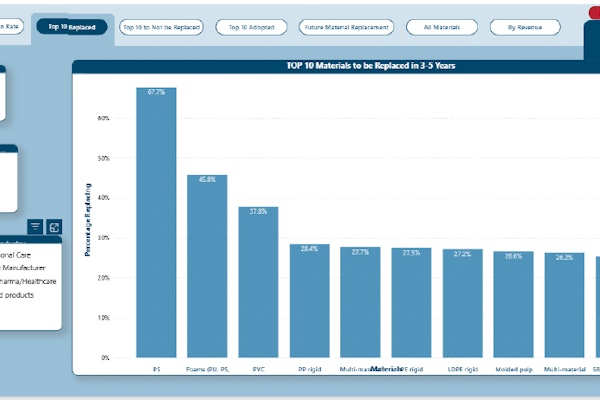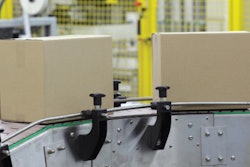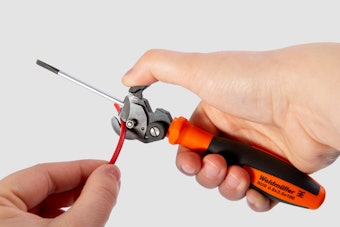Industry 4.0 and the Industrial Internet of Things (IIoT) have become mainstay terms in manufacturing, but will they become more than buzz words to the packaging and processing industries? The answer is, yes—with the right application.
Specifically, OEMs can harness IIoT-enabled technology like edge analytics—in which machine data is automatically collected and analyzed at a sensor or other connected device—to help improve overall equipment effectiveness (OEE), which end users are demanding. Edge analytics, which provides real-time information on machine status, could also open the door to new business models, like Machine-as-a-Service (MaaS), which can ensure customers aren’t spending a dime more than what’s being delivered by their capital equipment.
At first glance, the biggest benefit of edge analytics is the ability to bypass sending data to the cloud, which poses IT security risks. However, there often is a cloud component to the edge if the end user wants the OEM to manage the data. As a result, the same obstacles OEMs encounter when providing predictive maintenance, data analysis, and remote monitoring services, also plague edge analytics, as each obstacle points to one common pain point: the cloud—which the edge relies on to make the most impact.
But, it’s the ability to capture and act on machine data immediately that is the true value of the edge. And there are ways that machine builders can tap into the power of edge analytics now to improve their equipment, OEE, and customer relationships. Then OEMs need to figure out how to sell the benefits of the edge and the cloud combined to their customers to unlock the opportunities for new business models and critical failure prevention.
Defining edge
As defined by the Industrial Internet Consortium (IIC), edge computing happens when machine analytics are gathered or analyzed on the network or near the source of data, typically via an HMI or PLC connected to the equipment.
To effectively deploy edge analytics, a machine builder would need to invest in edge computing technologies such as software applications to process and display data, and cloud services like Azure, Amazon AWS, or Google Cloud to house the data—if it will be exported from the machine. An OEM will also need to either retrofit its legacy equipment or build its new equipment to include sensors, HMIs, PLCs, and other components that connect, communicate, and provide data. Machine builders can also seek out third party IoT service providers for advice and consultation on adding an edge computing feature to its equipment, as well as the automation and component suppliers they currently work with.
Once all systems are in place, components can start communicating analytics in real-time, which can either be stored on an edge device in a customer’s facility or exported to the cloud for Big Data analysis or additional storage. In order to be compatible with the edge, devices need to support edge-computing capabilities, such as local computing and storage and communication, according to IIC.
When paired with the cloud, artificial intelligence, and machine learning, machine builders have the potential to virtually eliminate downtime, skyrocket OEE, and create new business models and revenue streams.
“We are talking about sub-second and milli-second latency, which is crucial if you want to make decisions while a product is on the production line,” says Ramya Ravichandar, vice president of product management at FogHorn, a developer of edge intelligence software. “If a bottle manufacturer is filling bottles with soda or water, they want to make sure they have the right amount of liquid in the bottle and ensure that it’s bottled well before the bottle gets onto the next stage of the process. If organizations rely on sending it back to the cloud, it may be too late to make critical production changes in real-time. By bringing processing close to the edge, you are able to make decisions about how you can change the operation on the floor.”
Benefits on the edge
Whether machine builders gather edge analytics on a monthly or yearly basis, or they are able to build and deploy architectures and systems that allow them to collect insights in real-time, gathering analytics can help OEMs understand their equipment better, which helps all parties.
OEMs can take it a step further and pair the edge with machine learning algorithms, a data analysis method—which is a subset of artificial intelligence—that automates analytical model building which can teach systems to identify patterns and make decisions to improve production or address a specific business problem. These analytical models are complex and require months of data to train and re-train. This process also requires regular data feeds from operating components, as well as a public or private cloud connection at the top of the edge continuum, to compute the data, according to IIC. But machine learning models also allow machine builders to “fix” production flaws with little to no human involvement. Algorithms and production resolutions can also be quickly deployed directly at the edge to mitigate cloud latency.
A successful deployment of this process looks like plastic processing equipment builder Milacron’s M-Powered IIoT suite, which includes the capability to carryout predictive maintenance using edge analytics and machine learning.
Lastly, edge analytics keeps machine data local which protects intellectual property.
There are different industries where data connectivity to external data networks, such as the cloud, are a security concern,” Ravichandar says. “I argue that edge computing is actually your emerging defense for security because you isolate the data and cut out risk of malicious attacks. It is self-contained software that runs offline, yet still provides insight into your machine.”
However, if a machine builder is adamant about importing critical data into the cloud to do predictive maintenance or machine learning, companies like FogHorn, Rockwell, Siemens, GE, and more have built in security features that can assist in reassuring end-users that their data is safe.
“We use private-line services for any communication over the cloud, and our structure ensures data is secure,” Ravichandar says. “If builders want to publish data to Google Cloud, there is a way for us to publish that directly from the edge to the cloud through a secure site. We have a number of different end-point publication mechanisms we are able to use.”
Who owns the data?
When machine data leaves an end user facility or is being monitored by an OEM, the question of “Who owns the data?” arises.
While a machine builder may have access to the data and may use past data to make decisions or improve equipment, it’s safe to say that most end users are adamant about owning the data that leaves the machines.
“I think end-users are concerned about their data,” FogHorn’s Ravichandar says. “They want to make sure the data stays within their plant. This is one of the main drivers of edge computing, as organizations don’t have to send the data back to the cloud. We are seeing that end-users are happy to explore the technology, yet would very much like to be the owner of the data.”
But Rockwell’s Henderson says OEMs may not necessarily want to own the data in the future, but they do want to figure out how they can achieve real time access to the data.
“I believe the industry as a whole is still on a cusp situation where we haven’t yet figured out how to provide that,” Henderson says. “I have seen situations where end users have multiple entities that have some kind of investment in various machines in different parts of the facility so they want to share the data across those entities. But some of the data goes into one cloud, and then another for the other entities, and they want to make sure everyone is looking at the same data at the same time, while also ensuring that OEMs have access, too. This approach helps them a lot because if the customer has a problem with this equipment, and the OEMs can identify the problems or at least have access to the data so they know the right engineer and parts to send, that can have a significant value to both parties.”
What’s the hang up?
While the benefits of edge analytics could change the way builders and end users operate, there are limitations and concerns that could curtail effective and thorough adoption of the technology.
As mentioned, connectivity to the cloud unlocks the full potential of edge. But winning that end user buy-in is hard. It could be easier if a machine builder can demonstrate that the benefits outweigh the risks.
“You could develop an incentivized-based program to make it worth the end user’s while to share machine data in real-time with machine builders,” says Noel Henderson, senior applications engineer for edge analytics at Rockwell Automation. “If the OEM can say, ‘If you give us access to this data, here is what you will get in return,’ and demonstrate that they can provide an outcome if they get access to the data, it will be critical.”
Without the cloud, accessing edge analytics in the most secure and acceptable fashion would require a machine builder to travel to the customer’s plant to pull the data from the source. This could obviously be a costly move, and would only allow the machine builder to collect months or weeks of data at once, instead of having insight into real-time data at any time. However, this collection method could still be very impactful.
But companies could also solve this by using the edge and pairing that with occasional imports to the cloud when necessary, and if permitted. Siemens is currently piloting a program called Siemens Industrial Edge through its MindSphere platform that could allow machine builders to master the balance between cloud and edge.
“We are really seeing a functional shift from the applications out of the cloud and closer to the machine,” says Colm Gavin, factory automation digitalization specialist for Siemens Industry, Inc. “But how do you get your application and data onto and off of your equipment? Do you take a USB stick and go to every one? That’s not very efficient. With Siemens Industrial Edge, the machine and edge devices could be running, not connected to any cloud system, and maybe it runs for a couple of weeks or months. But you may reconnect to the cloud if there is a software update for the devices or you need to gather data, and then pull the cord to the cloud connection once finished.”
Should a machine builder clear the hurdles of IT security concerns associated with exporting data, and decide to monitor edge analytics, an OEM must ask: Who is going to develop, monitor, and manage this new project and process?
As mentioned above, machine learning and artificial intelligence could allow a builder to change the way their equipment is running on the fly—should there be an operational flaw in the production line. But to do this, OEMs would need to develop and deploy algorithms based on the machine data they collect that would automatically recognize pending system failures to adjust equipment. OEMs like Milacron outsourced this process to ei3, a supplier of IoT services, to help them successfully build and deploy predictive maintenance models. But if an OEM didn’t want to tap the skills of a third party IoT services provider, they would have to hire talent that specializes in collecting data and developing algorithms for machines.
Embarking on an edge journey
Gathering edge analytics may not be practical for every packaging line or application, but it could stand to alleviate OEE and productivity pain points with end users.
One way machine builders can see if edge analytics could be practical for their business is to ask themselves if any of their machines or applications require, or could greatly benefit from, having immediate response horizons, or an action a machine or component needs to take once a trigger has been hit, according to Rockwell’s Henderson.
“It’s all about determining your response horizons,” Henderson says. “If you think of a car, it has a lot of real-time answers, telling you the status of a gas gauge, oil pressures, engine temperature, and other parameters that have a long response time. If your check oil light comes on, you know you have a few days to get it changed. But the sensors used when its time to deploy the airbag don’t have a long response horizon, so that is something you want handled on the edge [in order to] respond immediately. Machines using edge analytics could also have applications that require immediate changes.”
While the concept of edge may seem overwhelming to some, Henderson says machine builders have been using edge for quite some time.
“I don’t like to say there is nothing new under the sun, but if you look at proportional-integral-derivative controller (PID) loops and condition-based monitoring, you’ll see that we are just taking what we have been doing for the past two decades and changing how we code, implement, and deploy it,” Henderson says. “There is a higher level that can be done today in a controller and at the edge, which allows us to do higher level analytics for those very narrow, short times where we have response horizons in milliseconds. What used to have to be done offline, we can now do online. We don’t have to wait until the outcome happens, we can do something before it happens.”
Consider these factors to decide whether or not edge analytics are practical for your business:
- Determine which applications edge analytics would lend itself well to
- Find out what the PLC or HMI currently in use can or cannot do in terms of edge analytics
- Designate response horizons and parameters for equipment and components
- See if manufacturing customers would be open to providing access to edge analytics, or a connection to the cloud
- Determine which issues could be solved by harnessing edge analytics




















